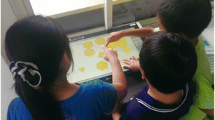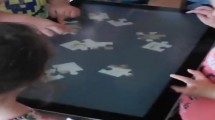Abstract
This study introduced computerized collaboration scripts with an intergroup competition mechanism to foster students’ within-group collaboration in a multi-touch tabletop classroom, investigating whether the scripting effects could be further improved by integrating intergroup competition. As such, this study utilized an experimental design to investigate the effects of intergroup competition on student teamwork performance, collaborative skills and learning achievement. A real-time intergroup competition mechanism was designed and integrated into a scripted multi-touch platform that supported collaborative designs. Forty-nine fifth-grade students from two classes at an elementary school in Taiwan were assigned to distinct groups, with and without intergroup competition. The participating students were required to accomplish a tessellation-related design project in small groups on a multi-touch platform. The findings showed that the students learning with the scripts under intergroup competition on multi-touch tabletop displays demonstrated better teamwork performance, collaborative skills and learning achievement than their counterparts who did not experience intergroup competition. These findings provide empirical evidence as to the effectiveness of integrating collaboration scripts with intergroup competition to computer-supported collaborative learning in multi-touch technology enhanced classrooms, delivering a better understanding of how learning with computerized collaboration scripts can be improved and how group awareness is related to this learning setting.






Similar content being viewed by others
Data availability
The data generated and/or analyzed during the current study are available from the corresponding author upon reasonable request.
References
Basheri, M., Munro, M., Burd, L., & Baghaei, N. (2013). Collaborative learning skills in multi-touch tables for UML software design. International Journal of Advanced Computer Science and Applications, 4(3), 60–66.
Beauchamp, G., Joyce-Gibbons, A., Mc Naughton, J., Young, N., & Crick, T. (2019). Exploring synchronous, remote collaborative interaction between learners using multi-touch tables and video conferencing in UK primary schools. British Journal of Educational Technology, 50(6), 3214–3232. https://doi.org/10.1111/bjet.12728.
Chen, C. H., & Chiu, C. H. (2015). The construction and application of a multi-touch platform for plane geometry learning. In J.-C. Liang, D. Gao, X. Gu, Y.-T. Wu, & B. Chang (Eds.), Workshops Proceedings of the 19th Global Chinese Conference on Computers in Education (pp. 33–37). Taoyuan, Taiwan: Global Chinese Society for Computers in Education.
Chen, C. H., & Chiu, C. H. (2016). Collaboration scripts for enhancing metacognitive self-regulation and mathematics literacy. International Journal of Science and Mathematics Education, 14, 263–280. https://doi.org/10.1007/s10763-015-9681-y.
Chiu, C. H., Chen, S. Y., & Wang, H. S. (2006). Studies of developing collaborative skills in web-based collaborative learning. In J. J. Hwang, & C. H. Wu (Eds.), Cooperative learning: Development and practice (pp. 385–426). Wu-Nan.
Clayphan, A., Kay, J., & Weinberger, A. (2014). ScriptStorm: Scripting to enhance tabletop brainstorming. Personal and Ubiquitous Computing, 18(6), 1433–1453. https://doi.org/10.1007/s00779-013-0746-z.
Dickinson, J. L., Crain, R. L., Reeve, H. K., & Schuldt, J. P. (2013). Can evolutionary design of social networks make it easier to be ‘green’? Trends in Ecology & Evolution, 28(9), 561–569. https://doi.org/10.1016/j.tree.2013.05.011.
Dillenbourg, P. (2002). Over-scripting CSCL: The risks of blending collaborative learning with instructional design. In P. A. Kirschner (Ed.), Three worlds of CSCL: Can we support CSCL? (pp. 61–91). Open Universiteit Nederland.
Dillenbourg, P., & Jermann, P. (2007). Designing integrative scripts. Scripting computer-supported collaborative learning (pp. 275–301). Springer. https://doi.org/10.1007/978-0-387-36949-5_16.
Domínguez, A., Saenz-de-Navarrete, J., de-Marcos, L., Fernández-Sanz, L., Pagés, C., & Martínez-Herráiz, J. J. (2013). Gamifying learning experiences: Practical implications and outcomes. Computers & Education, 63, 380–392. https://doi.org/10.1016/j.compedu.2012.12.020.
Harris, A., Rick, J., Bonnett, V., Yuill, N., Fleck, R., Marshall, P., & Rogers, Y. (2009). Around the table: Are multiple-touch surfaces better than single-touch for children’s collaborative interactions? In C. O’Malley, D. Suthers, P. Reimann, & A. Dimitracopoulou (Eds.), Proceedings of the 9th International Conference on Computer Supported Collaborative Learning - Volume 1 (pp. 335–344). Rhodes, Greece: International Society of the Learning Sciences.
Higgins, S., Mercier, E., Burd, L., & Joyce-Gibbons, A. (2012). Multi-touch tables and collaborative learning. British Journal of Educational Technology, 43(6), 1041–1054. https://doi.org/10.1111/j.1467-8535.2011.01259.x.
Ioannou, A. (2019). A model of gameful design for learning using interactive tabletops: Enactment and evaluation in the socio-emotional education classroom. Educational Technology Research and Development, 67(2), 277–302. https://doi.org/10.1007/s11423-018-9610-1.
Ioannou, A., Loizides, F., Vasiliou, C., Zaphiris, P., & Parmaxi, A. (2015). Tabletop support for collaborative design: An initial evaluation of IdeaSpace. Educational Media International, 52(4), 296–307. https://doi.org/10.1080/09523987.2015.1101222.
Kharrufa, A., Leat, D., & Olivier, P. (2010). Digital mysteries: Designing for learning at the tabletop. In Proceedings of the 5th ACM International Conference on Interactive Tabletops and Surfaces (pp. 197–206). New York, NY: Association for Computing Machinery. https://doi.org/10.1145/1936652.1936689.
Kollar, I., Ufer, S., Reichersdorfer, E., Vogel, F., Fischer, F., & Reiss, K. (2014). Effects of collaboration scripts and heuristic worked examples on the acquisition of mathematical argumentation skills of teacher students with different levels of prior achievement. Learning and Instruction, 32, 22–36. https://doi.org/10.1016/j.learninstruc.2014.01.003.
Markham, T., Larmer, J., & Ravitz, J. (2003). Project based learning handbook: A guide to standards-focused project based learning for middle and high school teachers (2nd ed.). Buck Institute for Education.
Martinez-Maldonado, R., & Goodyear, P. (2016). CoCoDeS: Multi-device support for collocated collaborative learning design. In Proceedings of the 28th Australian Conference on Computer-Human Interaction (pp. 185–194). New York, NY: Association for Computing Machinery. https://doi.org/10.1145/3010915.3010928.
Martinez-Maldonado, R., Yacef, K., & Kay, J. (2015). TSCL: A conceptual model to inform understanding of collaborative learning processes at interactive tabletops. International Journal of Human-Computer Studies, 83, 62–82. https://doi.org/10.1016/j.ijhcs.2015.05.001.
Massey, A. P., Ramesh, V., & Khatri, V. (2006). Design, development, and assessment of mobile applications: The case for problem-based learning. IEEE Transactions on Education, 49(2), 183–192. https://doi.org/10.1109/TE.2006.875700.
Mercier, E., Vourloumi, G., & Higgins, S. (2017). Student interactions and the development of ideas in multi-touch and paper-based collaborative mathematical problem solving. British Journal of Educational Technology, 48(1), 162–175. https://doi.org/10.1111/bjet.12351.
Miller, M., & Hadwin, A. (2015). Scripting and awareness tools for regulating collaborative learning: Changing the landscape of support in CSCL. Computers in Human Behavior, 52, 573–588. https://doi.org/10.1016/j.chb.2015.01.050.
Morris, R., Hadwin, A. F., Gress, C. L. Z., Miller, M., Fior, M., Church, H., & Winne, P. H. (2010). Designing roles, scripts, and prompts to support CSCL in gStudy. Computers in Human Behavior, 26(5), 815–824. https://doi.org/10.1016/j.chb.2008.12.001.
Oldham, G. R., & Baer, M. (2012). Creativity and the work context. In M. D. Mumford (Ed.), Handbook of organizational creativity (pp. 387–420). Academic Press. https://doi.org/10.1016/B978-0-12-374714-3.00016-1.
Radkowitsch, A., Vogel, F., & Fischer, F. (2020). Good for learning, bad for motivation? A meta-analysis on the effects of computer-supported collaboration scripts. International Journal of Computer-Supported Collaborative Learning, 15(1), 5–47. https://doi.org/10.1007/s11412-020-09316-4.
Rapp, A. (2017). Designing interactive systems through a game lens: An ethnographic approach. Computers in Human Behavior, 71, 455–468. https://doi.org/10.1016/j.chb.2015.02.048.
Reuben, E., & Tyran, J. R. (2010). Everyone is a winner: Promoting cooperation through all-can-win intergroup competition. European Journal of Political Economy, 26(1), 25–35. https://doi.org/10.1016/j.ejpoleco.2009.10.002.
Rick, J., Marshall, P., & Yuill, N. (2011). Beyond one-size-fits-all: How interactive tabletops support collaborative learning. In Proceedings of the 10th International Conference on Interaction Design and Children (pp. 109–117). Ann Arbor, MI: Association for Computing Machinery. https://doi.org/10.1145/1999030.1999043.
Romero, M. (2012). Learner engagement in the use of individual and collaborative serious games. Increasing student engagement and retention using immersive interfaces: Virtual worlds, gaming, and simulation (pp. 15–34). Emerald. https://doi.org/10.1108/S2044-9968(2012)000006C004.
Schnaubert, L., & Bodemer, D. (2019). Providing different types of group awareness information to guide collaborative learning. International Journal of Computer-Supported Collaborative Learning, 14(1), 7–51. https://doi.org/10.1007/s11412-018-9293-y.
Tauer, J. M., & Harackiewicz, J. M. (2004). The effects of cooperation and competition on intrinsic motivation and performance. Journal of Personality and Social Psychology, 86(6), 849–861. https://doi.org/10.1037/0022-3514.86.6.849.
Vogel, F., Wecker, C., Kollar, I., & Fischer, F. (2017). Socio-cognitive scaffolding with computer-supported collaboration scripts: A meta-analysis. Educational Psychology Review, 29(3), 477–511. https://doi.org/10.1007/s10648-016-9361-7.
Wen, F. H., & Chiou, H. J. (2009). Methodology of multilevel modeling: The key issues and their solutions of hierarchical linear modeling. NTU Management Review, 19(2), 263–294. https://doi.org/10.6226/NTURM2009.19.2.263.
Yu, F. Y., Han, C., & Chan, T. W. (2008). Experimental comparisons of face-to-face and anonymous real-time team competition in a networked gaming learning environment. CyberPsychology & Behavior, 11(4), 511–514. https://doi.org/10.1089/cpb.2007.0171.
Acknowledgements
This study was supported by the National Science and Technology Council, Republic of China (Taiwan) under Grant No. NSC 101-2511-S-003-033-MY3. The authors thank Mr. Zhen-An Wu’s coding assistance and Mr. Chris Herbert, who proofread this article. The authors thank the anonymous reviewers for their remarkably constructive comments.
Funding
This study was funded by the National Science and Technology Council, Republic of China (Taiwan) under Grant No. NSC 101-2511-S-003-033-MY3.
Author information
Authors and Affiliations
Contributions
CHChiu contributed to the study conception and design. Material preparation was performed by CHChiu and CHChen. Data collection and analysis were performed by CHChen. The first draft of the manuscript was written by CHChen and CHChiu commented on and revised previous versions of the manuscript. All authors read and approved the final manuscript.
Corresponding author
Ethics declarations
Conflicts of interest
The authors have no competing interests to declare that are relevant to the content of this article.
Ethical approval
All procedures performed in this study involving student participants were in accordance with the ethical standards of the institutional and/or national research committee and with the 1964 Helsinki Declaration and its later amendments or comparable ethical standards. The investigators obtained consent from the participating school and classroom teachers for experimentation. All of the students were informed that their participation was entirely voluntary, and that their responses would be confidential.
Consent to participate
Informed consent was obtained from all individual participants included in the study.
Additional information
Publisher’s note
Springer Nature remains neutral with regard to jurisdictional claims in published maps and institutional affiliations.
Rights and permissions
Springer Nature or its licensor (e.g. a society or other partner) holds exclusive rights to this article under a publishing agreement with the author(s) or other rightsholder(s); author self-archiving of the accepted manuscript version of this article is solely governed by the terms of such publishing agreement and applicable law.
About this article
Cite this article
Chen, CH., Chiu, CH. Computerized collaboration scripts and real-time intergroup competition for enhancing student collaboration and learning with multi-touch tabletop displays. Education Tech Research Dev 71, 2297–2320 (2023). https://doi.org/10.1007/s11423-023-10291-4
Accepted:
Published:
Issue Date:
DOI: https://doi.org/10.1007/s11423-023-10291-4




